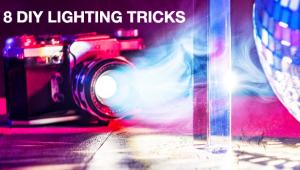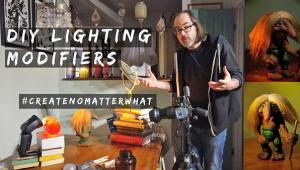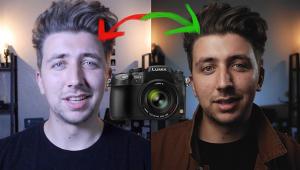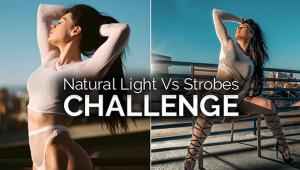Custom Brackets; Essential Auxilliary Light Accessories
There are two real reasons to use a flash bracket. The first is to raise the flash high enough above the lens so that shadows just drop behind the subject instead of off to one side. When keeping a suitable distance from the background, the shadow will usually just disappear. The second is to eliminate the dreaded "redeye" caused by the flash being too close to the lens. The position of the flash when using a ceiling bounce also has to be considered when choosing a bracket, as we'll see later. When most pros were running around shooting square-format cameras, the design was pretty simple. Just use a square foot on the bracket and an "L"-shaped arm for the flash. Keep in mind when I'm talking about a flash, I'm talking about a shoe-mount unit, not a handle mount. With the square, once the flash is positioned above the lens, you're done. If you shoot with the flash aimed at your subject, you're in business. If you want to bounce the flash, just flip the head up and go. But what about cameras based on 35mm bodies? Hmm, different story, with several different solutions. Let's take a look.
 |
|
|
To get a handle on flash brackets I recently tested a few varieties from a company called, appropriately enough, Custom Brackets. The first item I tried was the CB Junior. This is a rugged version of the traditional rotating bracket that "flips" the flash sideways when you want to take a vertical shot. They also sent me a few accessories (yes, they have accessories) like the camera anti-twist bar. If you've used this type of bracket for any length of time, you'll know that as the screw holding the camera to the bracket loosens, the camera will turn and get out of alignment with the flash. The bar mounts with two screws to the front of the plate, sticks up, and blocks any rotation. Cool, eh?
This type of bracket is fine for someone who doesn't use bounce flash a lot. It's a good choice to use as a "fill flash" taking outdoor portraits where bouncing wouldn't be a factor and it's small and lightweight (all the brackets are made from aluminum). It also has a little foldout leg so you can stand the whole rig up, nice when you need to put your rig down for a rest. While the company says it's adjustable, it seems made to be held with the right hand; reversing it puts the flash back farther, which might cause problems with fat lenses. The foam handle is very comfortable. At $112, it's also the least expensive bracket in the bunch I tested.
The next bracket I tried was the QRS-H2. This bracket is a totally different design. Instead of the bracket flipping, the camera rotates. This is accomplished by attaching the camera-specific mounting plate to the camera and then to the bracket. They use "special roller-bearing rotation" that they claim is smooth. It is. It feels like somebody greased it all up for you but you won't need to worry about your suit getting dirty because it's dry as a bone. It has a straight arm and a wooden grip. You can adjust the height of the horizontal bar that holds the flash. You will need a flash-mounting plate and quick-release plate also. With this unit the flash remains stationary so bounce flash is accomplished by just flipping the flash head up. All this high-tech stuff will cost you. The bracket is $225, plus the other little bits bring the total to $329.
Now we're on to my favorite, the Digital PRO-M. I'm not quite sure why it's called "digital"; I'm guessing it would work with a Nikon F6. I'm pretty sure it's the marketing guys at work letting everyone know that this is made for your latest digital wonder. Anyway, this bracket does the job it was designed to do and handles flash units and bounces and camera rotation with ease and finesse. You're holding a beautifully designed and manufactured piece of equipment in your hands, and if you're a serious wedding photographer I can't think of why you shouldn't have one. It's cool black aluminum; it has a foam grip that I much prefer to wood; and it has that slick roller stuff going on that makes rotation a snap. You've got proper flash orientation whether it's vertical, horizontal, or ceiling bounce. The flash height is adjustable, it collapses for packing, and it has two tiny little legs so it can stand up next to the wedding cake.
The only reason you might possibly not want one is price. Fitted out with all the goodies you need, it'll set you back $435. Think of it as an investment in a piece of gear you'll have practically forever, and the first time you use it you'll wonder why you didn't get one years ago. Frankly, I've had my share of flimsy flash brackets. I can't tell you what happened to most of them, but I can tell you I still have my Custom Brackets. It's the good stuff.
For more information, contact Custom Brackets, 32 Alpha Park, Cleveland, OH 44143; (440) 646-9851; www.custombrackets.com.
Steve Bedell holds Masters and Craftsman degrees from the Professional Photographers of America. Bedell recently released an educational DVD about shooting in the sun called "Sparkle Light." For more information on the DVD or to subscribe to EPhoto, his free online newsletter for professional and advanced amateur photographers, contact Bedell via e-mail at: sb@stevebedell.com.
- Log in or register to post comments

















































